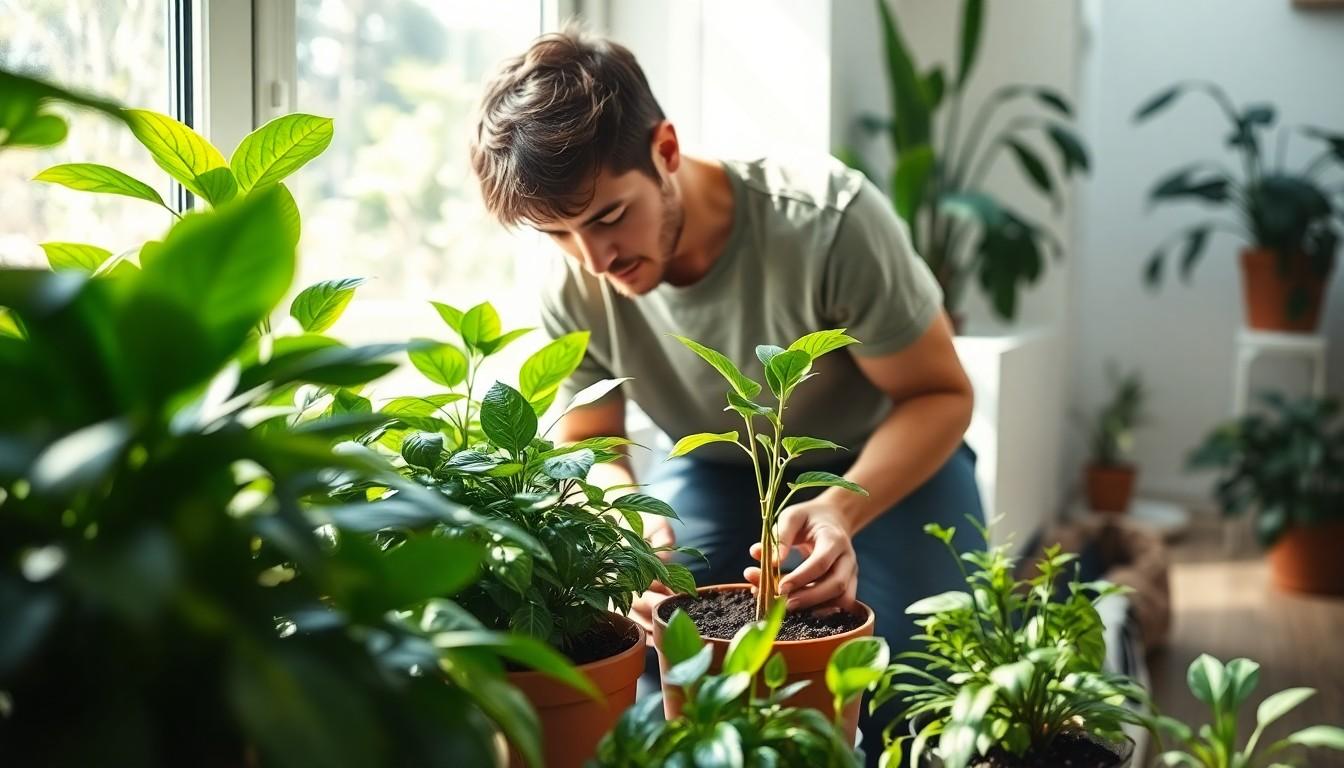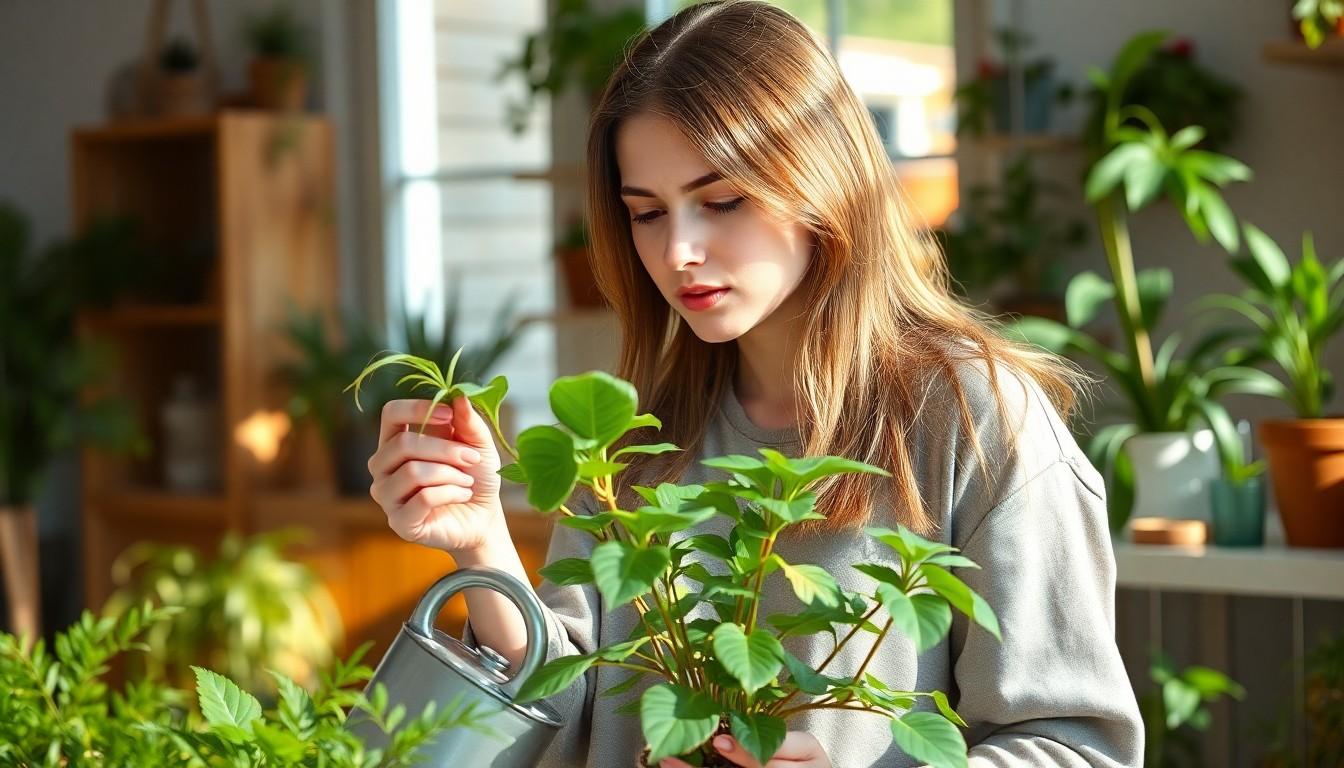Indoor plants can bring life and joy to any space, but when they start to droop and turn brown, it feels like a mini funeral for your leafy friends. Don’t worry, though—there’s hope! With a little TLC and some insider tips, even the most bedraggled plant can bounce back to its green glory.
Understanding Why Plants Die Indoors
Indoor plants often struggle due to various factors that hinder their growth. Recognizing these challenges can help revive dying plants.
Common Causes of Plant Decline
Insufficient light contributes significantly to plant decline. Many indoor plants require bright, indirect sunlight to thrive. Overwatering can lead to root rot, a common issue in indoor gardening. When soil remains saturated, roots suffocate and decay. Pests, such as spider mites and aphids, can devastate plants if not treated promptly. Nutritional deficiencies often occur in plants that lack adequate fertilization, resulting in stunted growth. Lastly, improper humidity levels may stress plants. Many species prefer higher humidity, which indoor environments often lack.
Signs That Your Plant Is Dying
Wilting leaves frequently indicate a struggling plant, signaling insufficient water or light. Brown tips on leaves suggest over-fertilization or insufficient humidity, leading to leaf scorch. Yellowing leaves often point to overwatering or nutrient deficiencies, impacting overall health. Dropping leaves is another critical sign; plants shedding leaves indicate stress or environmental changes. Fungal growth on soil surfaces implies an overabundance of moisture, warranting immediate attention. Inspecting plants regularly can help catch these signs early, increasing the chance of revival.
Steps to Revive Dying Plants

Reviving dying indoor plants requires assessing their environment and adjusting care practices. Start with an evaluation of light conditions and watering habits.
Assessing Light Conditions
Insufficient light often contributes to a plant’s decline. Observe the current location; if natural light is inadequate, consider moving the plant closer to a window. Some plants thrive in bright, indirect light, while others prefer lower light levels. Check the specific needs of each plant type to ensure proper exposure. Use sheer curtains to diffuse strong sunlight if necessary. If the plant shows signs of stretching towards the light, it’s a strong indication it needs brighter conditions. Additionally, rotating plants weekly promotes even growth and prevents lopsided development.
Adjusting Watering Practices
Overwatering leads to root rot, while underwatering results in dehydration. Assess the soil moisture; sticking a finger into the soil can determine dryness. Water once the top inch feels dry to the touch. Ensure pots have drainage holes to prevent excess water accumulation. Use a measuring cup to deliver precise amounts instead of guessing. Adjust frequency according to seasonal changes; plants typically require less water in cooler months. Observing yellowing leaves or wilting can provide further clues on watering needs, guiding appropriate adjustments.
Soil and Fertilization Techniques
Proper soil and fertilization are essential for the health of indoor plants. Choosing the right soil mix provides a solid foundation for growth and recovery.
Choosing the Right Soil Mix
Select a soil mix tailored to specific plant needs. Well-draining potting soil often suits most indoor plants, allowing for proper aeration. Incorporating organic matter enhances nutrient retention and promotes healthy root development. For moisture-loving plants, a blend containing peat moss and vermiculite works best. Cacti and succulents thrive in sandy mixes, which prevent water logging. Always consider repotting plants with compacted soil to improve drainage and root space.
When and How to Fertilize
Fertilization timing and method significantly impact plant recovery. Use a balanced, water-soluble fertilizer during the growing season, typically spring through summer. Dilute the fertilizer according to package instructions to avoid over-fertilization. Apply every four to six weeks for optimum results. Observe plants closely; if growth stagnates or leaf color fades, adjust the fertilization schedule accordingly. During the dormant season, reduce or eliminate fertilizer to prevent stress on plants.
Pest and Disease Management
Maintaining healthy indoor plants involves effectively managing pests and diseases. Taking prompt action can significantly improve plant survival.
Identifying Common Pests
Recognizing pests is crucial for indoor plant care. Aphids appear as tiny insects on leaves, often causing distortion. Spider mites produce fine webs and result in stippling on the foliage. Mealybugs look like cottony masses, usually found in leaf axils. Scale insects resemble small bumps on stems or leaves, weakening the plant. Fungal gnats emerge from damp soil and indicate overwatering. Regularly inspecting plants helps to catch these pests early. Utilizing magnifying glasses can assist in detecting tiny invaders.
Natural Remedies for Plant Diseases
Several effective natural remedies exist for treating plant diseases. Neem oil acts as a repellent and antifungal agent, easily diluted with water for application. Baking soda mixed with water serves as a fungicide, combating powdery mildew. Soap solutions can treat aphids and spider mites, created using mild liquid soap and water. Additionally, maintaining proper humidity and air circulation supports disease prevention. Using sterile tools prevents the spread of pathogens during plant care. These approaches enhance plant vitality and contribute to a thriving indoor garden.
Preventive Measures for Healthy Indoor Plants
Proper preventive measures can ensure indoor plants remain vibrant and thriving. Implementing effective routines and choosing suitable varieties helps maintain plant health.
Choosing Resilient Plant Varieties
Selecting resilient plant varieties plays a significant role in indoor gardening success. Consider plants like snake plants, pothos, and ZZ plants, known for their ability to withstand neglect. These options require minimal care and adapt well to varying light conditions. Varieties such as peace lilies thrive even in lower light environments, providing an excellent aesthetic choice. Exploring options suited to individual lifestyles often leads to greater satisfaction and reduced stress.
Ideal Indoor Plant Care Routine
Establishing a regular care routine is crucial for indoor plant health. Assessing light exposure is essential; some plants thrive in bright light, while others prefer shade. Watering should happen when the top inch of soil feels dry, ensuring that roots receive adequate moisture without drowning. Fertilizing during the growing season supports plant nourishment; a balanced, water-soluble fertilizer typically suffices. Regularly checking for pests and adjusting humidity levels contribute to a thriving indoor environment. Incorporating these practices helps keep indoor plants healthy and resilient.
Conclusion
Reviving dying indoor plants is entirely achievable with the right approach and consistent care. By understanding the specific needs of each plant and making necessary adjustments to their environment, plant owners can breathe new life into their green companions. Regular assessments of light, water, soil, and pest conditions are essential for fostering a healthy indoor garden.
Embracing preventive measures and selecting resilient plant varieties can further enhance success. With patience and dedication, even the most struggling plants can flourish, transforming any indoor space into a vibrant oasis. Taking these steps not only nurtures plants but also enriches the overall experience of indoor gardening.

